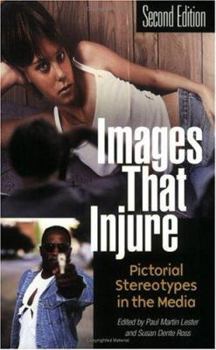Images That Injure: Pictorial Stereotypes in the Media
Select Format
Select Condition 
Book Overview
This expanded collection of new and fully revised explorations of media content identifies the ways we all have been negatively stereotyped and demonstrates how careful analysis of media portrayals... This description may be from another edition of this product.
Format:Paperback
Language:English
ISBN:027597846X
ISBN13:9780275978464
Release Date:September 2003
Publisher:Praeger
Length:336 Pages
Weight:1.20 lbs.
Dimensions:1.0" x 6.0" x 9.0"
Related Subjects
Business Business & Finance Business & Investing Communication Communication & Journalism Communication & Media Studies Communications Education & Reference Humanities Language Arts Library & Information Science Media Studies Parenting & Relationships Politics & Social Sciences Psychology Social Science Social Sciences Textbooks Words, Language & GrammarCustomer Reviews
1 rating
Helpful Overview of Our Own Stereotypes
Published by Thriftbooks.com User , 16 years ago
I used this text for a lecture in a class I taught on Theology and Film. The authors provide a great summary of how we stereotype, and thus do violence to one another. And yet, stereotypes are part of our shared culture. I think we surprised ourselves as we could all too easily name the stereotypes that the authors draw out. We participate in these views even though we reject them. It is this reality upon which the writers of sitcoms rely. We may laugh at these stereotypes because they are shared, and we are in on the joke. We may see these things in our own life experiences and yet reject them because we ourselves would not want to be reduced to this wooden image. Writing in books and films are dependent upon stereotypes. The authors remind us that stereotypes become harmful when they are combined with prejudice, ignorance, and discrimination. "History has shown that stereotyping can lead to scapegoating, which can lead to discrimination, which can lead to segregation, which can led to physical abuse, which can lead to state-sponsored genocide." "Media stereotypes reinforce and magnify our personal stereotypes. As a consequence, media stereotypes play a significant role in the social disintegration that produces hatred, violence, and misunderstanding. Images are especially powerful because visual messages are products of our sense of sight, not our cognition. Pictures are highly emotional objects that have long-lasting staying power within the deepest regions of the brain. Bur both textual and visual media messages that stereotype individuals by their concentrations, frequency, and omissions become a part of our long term individual and cultural memory. And when certain individuals or ethnicities appear only as criminals, entertainers, and sports heroes, we forget that the vast majority of people--regardless of their particular cultural heritage--have the same hopes and fears as the rest of us."






